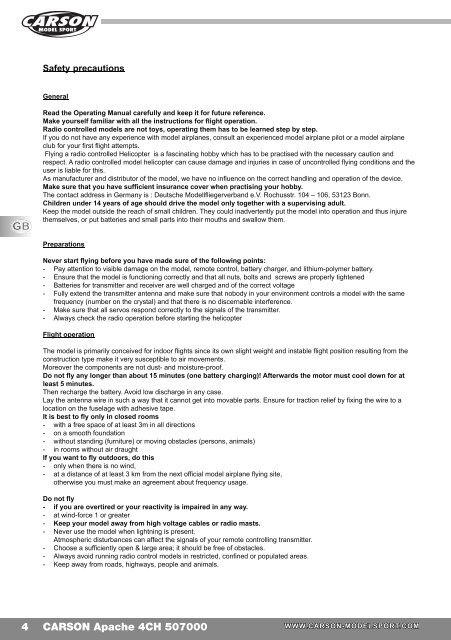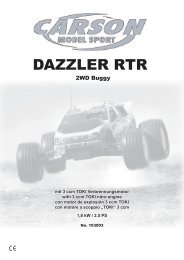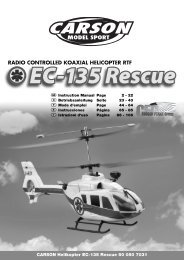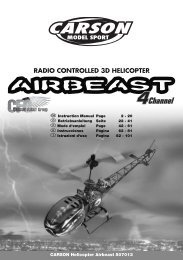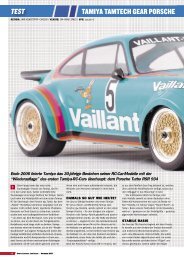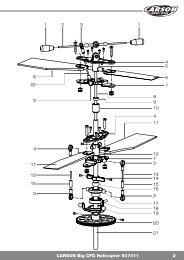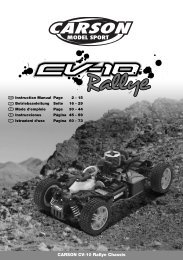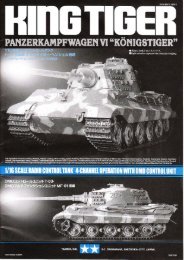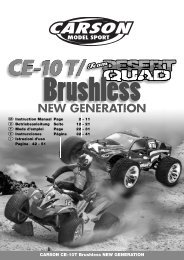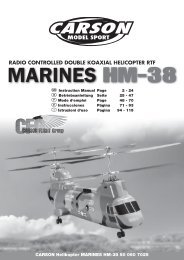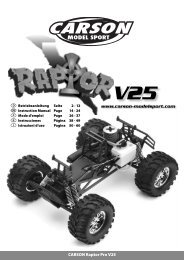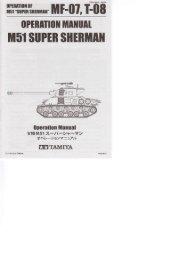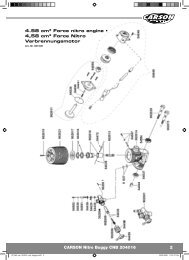APACHE 4 CH - Tamiya
APACHE 4 CH - Tamiya
APACHE 4 CH - Tamiya
- No tags were found...
You also want an ePaper? Increase the reach of your titles
YUMPU automatically turns print PDFs into web optimized ePapers that Google loves.
Safety precautionsGeneralRead the Operating Manual carefully and keep it for future reference.Make yourself familiar with all the instructions for flight operation.Radio controlled models are not toys, operating them has to be learned step by step.If you do not have any experience with model airplanes, consult an experienced model airplane pilot or a model airplaneclub for your first flight attempts.Flying a radio controlled Helicopter is a fascinating hobby which has to be practised with the necessary caution andrespect. A radio controlled model helicopter can cause damage and injuries in case of uncontrolled flying conditions and theuser is liable for this.As manufacturer and distributor of the model, we have no influence on the correct handling and operation of the device.Make sure that you have suf cient insurance cover when practising your hobby.The contact address in Germany is : Deutsche Modellfliegerverband e.V. Rochusstr. 104 – 106, 53123 Bonn.Children under 14 years of age should drive the model only together with a supervising adult.Keep the model outside the reach of small children. They could inadvertently put the model into operation and thus injurethemselves, or put batteries and small parts into their mouths and swallow them.PreparationsNever start ying before you have made sure of the following points:- Pay attention to visible damage on the model, remote control, battery charger, and lithium-polymer battery.- Ensure that the model is functioning correctly and that all nuts, bolts and screws are properly tightened- Batteries for transmitter and receiver are well charged and of the correct voltage- Fully extend the transmitter antenna and make sure that nobody in your environment controls a model with the samefrequency (number on the crystal) and that there is no discernable interference.- Make sure that all servos respond correctly to the signals of the transmitter.- Always check the radio operation before starting the helicopterFlight operationThe model is primarily conceived for indoor flights since its own slight weight and instable flight position resulting from theconstruction type make it very susceptible to air movements.Moreover the components are not dust- and moisture-proof.Do not fly any longer than about 15 minutes (one battery charging)! Afterwards the motor must cool down for atleast 5 minutes.Then recharge the battery. Avoid low discharge in any case.Lay the antenna wire in such a way that it cannot get into movable parts. Ensure for traction relief by fixing the wire to alocation on the fuselage with adhesive tape.It is best to fly only in closed rooms- with a free space of at least 3m in all directions- on a smooth foundation- without standing (furniture) or moving obstacles (persons, animals)- in rooms without air draughtIf you want to fly outdoors, do this- only when there is no wind,- at a distance of at least 3 km from the next official model airplane flying site,otherwise you must make an agreement about frequency usage.Do not fly- if you are overtired or your reactivity is impaired in any way.- at wind-force 1 or greater- Keep your model away from high voltage cables or radio masts.- Never use the model when lightning is present.Atmospheric disturbances can affect the signals of your remote controlling transmitter.- Choose a sufficiently open & large area; it should be free of obstacles.- Always avoid running radio control models in restricted, confined or populated areas.- Keep away from roads, highways, people and animals.4 CARSON Apache 4<strong>CH</strong> 507000 WWW.CARSON-MODELSPORT.COM


